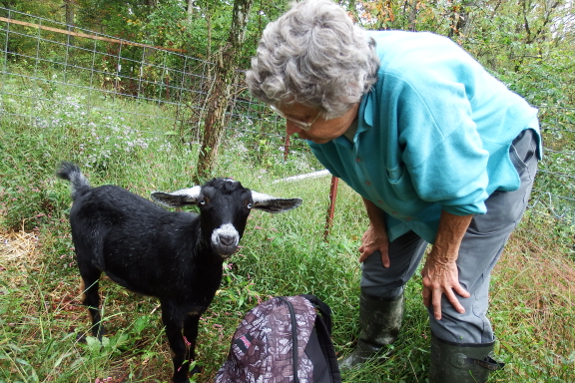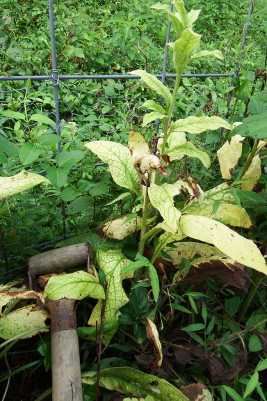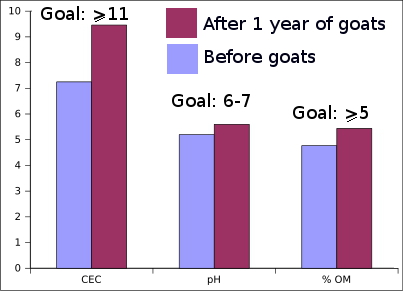
Remineralizing with animals

Our goat pastures are flattish and dryish, but otherwise contain some of our farm's worst soil. Seriously, nothing
but black locusts would grow there for the longest time. Even the
ground was nearly bare of herbaceous growth (aka grasses and weeds). So I
sent away a soil sample last fall, and the results confirmed my
suspicions --- this area needs help. The CEC was 7 and the pH was 5.2. No wonder plants kicked the bucket before they had time to get their feet under them.
 Now,
I'd planned to use the fast, traditional approach to solving my
acidic-soil problem --- adding lots of lime. But last winter was so wet I
would have had to carry dozens of 50-pound bags back to our core
homestead on my back. And our local feed stores suddenly only sold dolomitic limestone...which I don't want to apply because our soil is already overfull of magnesium. So I dropped the ball, ahem, decided to experiment with using ruminants to improve the soil.
Now,
I'd planned to use the fast, traditional approach to solving my
acidic-soil problem --- adding lots of lime. But last winter was so wet I
would have had to carry dozens of 50-pound bags back to our core
homestead on my back. And our local feed stores suddenly only sold dolomitic limestone...which I don't want to apply because our soil is already overfull of magnesium. So I dropped the ball, ahem, decided to experiment with using ruminants to improve the soil.
My experimental protocol
was simple --- use this pasture as a sacrifice area over the winter,
letting the goats poop there with wild abandon. Then, this summer, I
turned our herd of two into the same pasture at least a third of the
time, even when the does were clearly too spoiled to eat the grass and
weeds growing therein. In other words, I was taking hay from some other
farmer along with weeds and tree leaves from our own woods and gardens,
passing the plant matter through our goats' bellies, and using their
manure to fertilize the pasture's poor soil.
 The
results were astonishing. CEC increased by 30%, percent organic matter
improved by 14%, and pH rose to 5.6. And plants also started to grow!
Not lush, thriving jungles of weeds the way we see in other parts of our
core homestead. But at least I stopped noticing comfrey so deficient in
nutrients its leaves were pale yellow.
The
results were astonishing. CEC increased by 30%, percent organic matter
improved by 14%, and pH rose to 5.6. And plants also started to grow!
Not lush, thriving jungles of weeds the way we see in other parts of our
core homestead. But at least I stopped noticing comfrey so deficient in
nutrients its leaves were pale yellow.
Meanwhile, calcium levels of the soil also rose, even though I applied no lime. If you're a proponent of remineralization,
you want 60 to 70% of the cation exchange sites in your soil to be full
of calcium. Pre-goats, our pasture soil was at a measly 33%; now the
calcium percentage is 42%.
Maybe in another two or three years, this soil will have been entirely
remineralized...all due to kelp-fed goats. Do you think then our darling
does will then deign to dine on their own grasses?
Want more in-depth information? Browse through our books.
Or explore more posts by date or by subject.
About us: Anna Hess and Mark Hamilton spent over a decade living self-sufficiently in the mountains of Virginia before moving north to start over from scratch in the foothills of Ohio. They've experimented with permaculture, no-till gardening, trailersteading, home-based microbusinesses and much more, writing about their adventures in both blogs and books.
Want to be notified when new comments are posted on this page? Click on the RSS button after you add a comment to subscribe to the comment feed, or simply check the box beside "email replies to me" while writing your comment.

Hey Anna,
You have talked a number of times in the past about remineralization and soil testing. Do you have a good place to start learning about the process? I want to do some soil tests on my pastures/garden area to see how to improve the quality but that means figuring out what soil test to do and how to interpret it.
Terry --- I'm glad you enjoyed it!
BW --- You can start out by reading my lunchtime series about The Intelligent Gardener. Or, if you want to wait, I'm working on a book about soil that will sum up everything I've learned to date. It'll probably be out this coming spring.
Seeding that developing soil with Ladino clover or whatever perrenial clover does well there might help too? If nothing else it will fix more Nitrogen in the soil and add more vegetable matter.
I have been refining clay in my back yard using 5 gallon buckets getting ready to plant a-la-Masanobu-Fukuoka clover and barley clay seed balls. The clover from my first failed fragmented seed balls (too much sand - thus the refining operation) were discarded in my back yard and I swear they took 24 hours to sprout. We have a good bit of warmer weather ahead of us here near Savannah GA so hoping there will be enough time for them to get established.